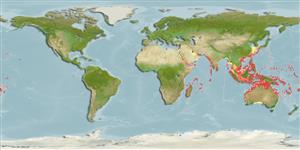Classification / Names
Common names from other countries
Main reference
Size / Weight / Age
Max length : 87.0 cm TL male/unsexed; (Ref. 47613); common length : 70.0 cm TL male/unsexed; (Ref. 5450); max. published weight: 8.4 kg (Ref. 40637); max. reported age: 28 years (Ref. 92312)
Length at first maturity
Lm 39.4, range 41 - ? cm
Environment
Marine; brackish; reef-associated; non-migratory; depth range 10 - 75 m (Ref. 2295)
Climate / Range
Tropical, preferred 28°C (Ref. 107945); 34°N - 34°S, 25°E - 170°W
Distribution
Indo-West Pacific: Red Sea, Persian Gulf and East Africa to southern Japan and Samoa. According to a genetic study (Ref. 28017), Lethrinus nebulosus and Lethrinus choerorynchus are two distinct species in Western Australia.
Countries | FAO areas | Ecosystems | Occurrences | Introductions
Short description
Dorsal
spines
(total): 10;
Dorsal
soft rays
(total): 9;
Anal
spines: 3;
Anal
soft rays: 8. Cheek without scales; 5-9 scales in supra temporal patch; inner surface of pectoral fin densely covered with scales; posterior angle of opercular fully scaled. Body color is yellowish or bronze, lighter below. Centers of many scales with a white or light blue spot. Sometimes irregular dark indistinct bars on sides and a square black blotch above pectoral fin bordering below the lateral line. Three blue streaks or series of blue spots radiate forward and ventrally from the eye. The fins are whitish or yellowish; the pelvic dusky, the edge of the dorsal fin is reddish. TL/SL relationship (cm): TL = 1.70 +1.24. Juveniles variable with blotches or stripe and changes with habitat (Ref. 48635).
IUCN Red List Status (Ref. 115185)
Threat to humans
Reports of ciguatera poisoning (Ref. 31637)
Human uses
Fisheries: highly commercial; aquaculture: commercial; gamefish: yes
Tools
Special reports
Download XML
Internet sources
Estimates of some properties based on models
Phylogenetic diversity index
PD50 = 0.5000 many relatives (e.g. carps) 0.5 - 2.0 few relatives (e.g. lungfishes)
Trophic Level
3.8 ±0.2 se; Based on diet studies.
Resilience
Low, minimum population doubling time 4.5 - 14 years (K=0.09-0.16; tm=4-9; tmax=27)
Vulnerability
Moderate to high vulnerability (47 of 100)
Price category
